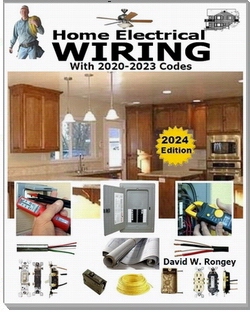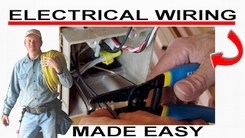» Need Electrical Help? Ask the Electrician
Heat Pump Wiring

|
By Dave Rongey
Summary: Heat pumps are used for heating and cooling. Wall mounted units are great for offices, sunrooms, room additions, garages and are used in hotel and motel rooms. © By: Dave Rongey |
The Basics about Heat Pumpsand the Electrical Requirements
What is a Heat Pump that is Wall Mounted?
Heat pumps are very similar to cooling-only systems, with one exception. A special valve in the refrigeration system allows the refrigeration cycle to be operated in reverse.
A cooling only system cools the indoor air and discharges heat to the outdoors. A heat pump that is wall mounted can also cool the indoor air, but when the valve is reversed, the indoor air is heated.
A supplementary electric heater may also be used to assist the heat pump at lower outdoor temperatures. In colder climates, heat pumps do require a defrost period, during which the electric heater is the primary source of heating the interior of the building.
Heat Pump Wall Mounted Unit |
What is a PTAC / PTHP Heat Pump? A PTAC ( packaged terminal air conditioner) is a unit that cools and heats. These are heat pumps wall mounted for space saving and convenience. A PTAC provides warm air using an electric heater (heat strip). A PTHP ( packaged terminal heat pump) uses its compressor all year round to either heat or cool. In warm weather, they efficiently capture heat from inside the building and pump it outside for cooling. How a Heat Pump Wall Mounted Works In cool weather, they capture heat from outdoor air and pump it into the building, adding heat from electric heat strips as necessary, in order to efficiently provide heat. |
| Control Panel | |
When the external temperature is 38 degrees Fahrenheit or lower, a PTHP unit switches to heat strip operation in order to provide heat. PTHP units are similar to a high quality version of the window-mounted air conditioner with the heat pump accessories added.
|
The Safest Way to Test Electrical Devices and Identify Electric Wires!The Non-Contact Electrical TesterThis is a testing tool that I have had in my personal electrical tool pouch for years, and is the first test tool I grab to help identify electrical wiring. It is a Non-contact tester that I use to easily Detect Voltage in Cables, Cords, Circuit Breakers, Lighting Fixtures, Switches, Outlets and Wires. Simply insert the end of the tester into an outlet, lamp socket, or hold the end of the tester against the wire you wish to test. Very handy and easy to use.
The Quickest Way to Check for Faulty Electrical Wiring!The Plug-In Outlet TesterThis is the first tool I grab to troubleshoot a problem with outlet circuit wiring. This popular tester is also used by most inspectors to test for power and check the polarity of circuit wiring. It detects probable improper wiring conditions in standard 110-125 VAC outlets Provides 6 probable wiring conditions that are quick and easy to read for ultimate efficiency Lights indicate if wiring is correct and indicator light chart is included Tests standard 3-wire outlets UL Listed Light indicates if wiring is incorrect Very handy and easy to use.
Strip Off Wire Insulation without Nicking and Damaging the Electric Wire!The Wire Stripper and Wire CutterMy absolute favorite wire stripping tool that I have had in my personal electrical tool pouch for years, and this is the tool I use to safely strip electrical wires. This handy tool has multiple uses: The wire gauges are shown on the side of the tool so you know which slot to use for stripping insulation. The end of the tool can be used to grip and bend wire which is handy for attaching wire onto the screw terminals of switches and outlets.. The wire stripper will work on both solid and stranded wire. This tool is Very Handy and Easy to Use. |
||
Residential Electrical Parts and AccessoriesLight Switches 120volt Outlets Circuit Breakers Electrician Tools Voltage Testers |















